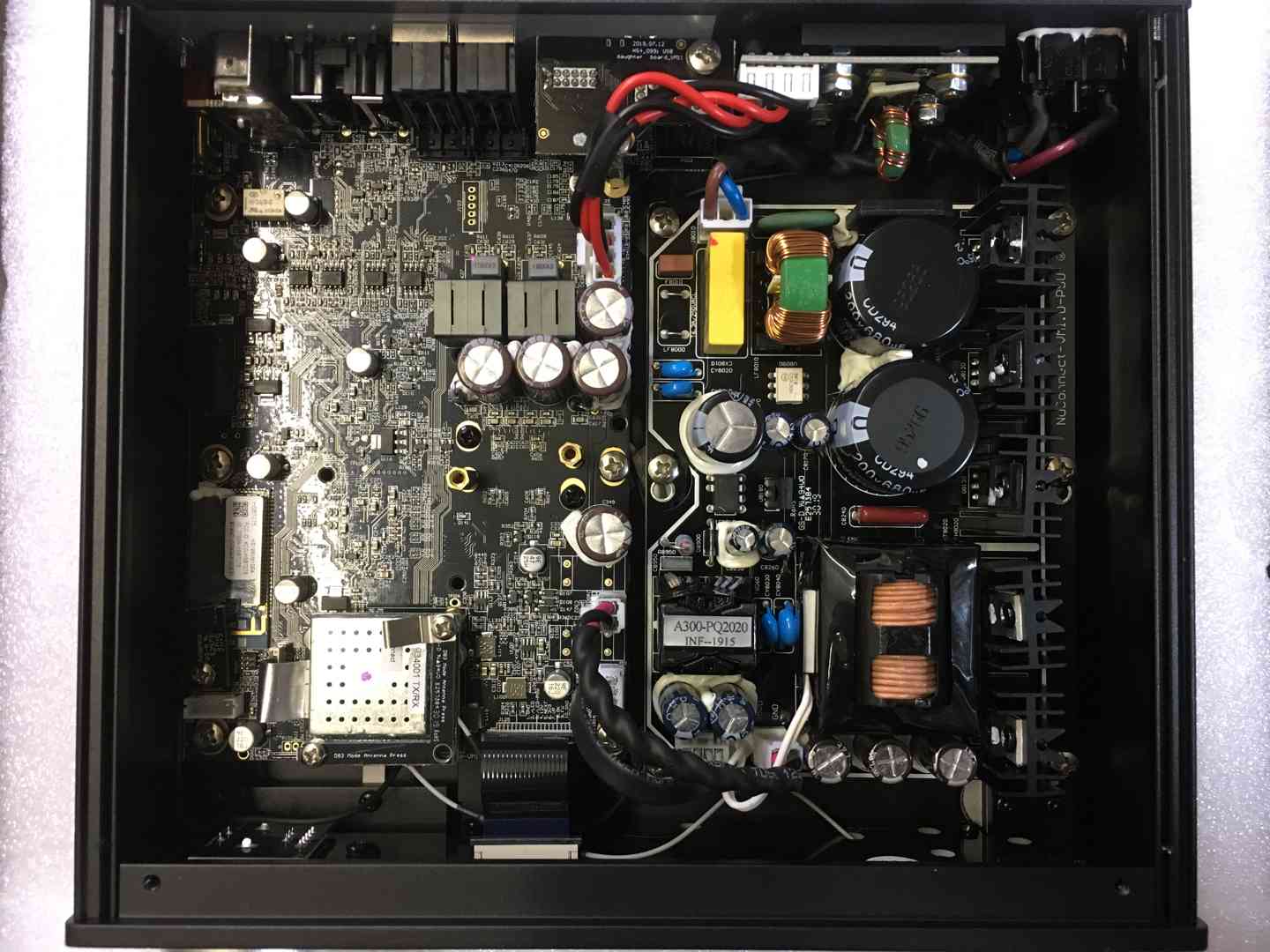This is a review and detailed measurements of the Nubert nuConnect ampX digital integrated amplifier and wireless connector. It was purchased by a member from the company in Germany and drop shipped to me. The ampX costs €689 (US $766).
The outside imparts confidence as far as weight and industrial design:

Beauty is skin deep though. The menu structure is very strange. For example you hit the "return" button to get into options and then rotate the number to select. Hitting return gets you back one step but never back to home menu above. You have to select "Volume" and click on that to get back home. I had the volume too high once as soon as I changed inputs and could not turn it down immediately.
When you turn the unit off with the standby button on the left, a dim display remains saying ampX. I hope that is not an OLED display or that would be burnt in after a short while. Why do I need to see that text on the display? The standby button already turns orange.
The rear panel shows the plethora of option to feed the ampX:

You have phono state, Bluetooth, and Wifi besides allt he other inputs. What's more using their app and the microphone in the phone you are supposed to be able to correct for room modes under 160 Hz (I did not test this).
Audio Measurements
I started with our usual dashboard with USB input to ampX and speaker out at 5 watts:

Boy, this is not good. We have high noise floor plus ton sand tons of harmonics and we are at just 5 watts. I thought may be analog input would be different so tested that:

It is a different sort of bad but overall in the same bucket of "well below average:"

Signal to noise ratio is verypoor:

Never seen an amplifier that doesn't improve its signal to noise ratio when you turn it up. The noise must be getting amplified proportionally with volume.
32-tone test signal resembling "music" shows the same problems:

Look at those spikes in mid frequencies rising to almost -50 dB. This is where our hearing is starting to get most sensitive.
Frequency response was terrible with digital or analog inputs:

There is a high pass filter which I could not figure how to defeat so let it be at 10 Hz. It must cause that terrible peaking at low frequencies. Conversely, there is a sharp filter at 20 kHz which roll off starting even earlier. We are down 3 dB by the time we get to 20 kHz. And this is with digital input and sample rate of 96 kHz!
Let's test the power amp to full power starting at 4 ohm:

That is a lot worse than a typical AVR. Same is true with 8 ohm load:

Thermal Analysis
Performance improved a bit over half of running at 5 watts:

Conclusions
I tell you: if manufacturers post measurements, I am sure they would have caught these issues themselves. Even a marketing person would know the above frequency response would not sell a single unit. But no. Customers don't ask for it so manufactures just throw a few numbers over the fence. Those numbers did point to problems:

We actually did better at 0.05%! How they got this SNR, I don't know :

Conclusions
I get the appeal of "do it all" amplifier with modern streaming features. But come on. Let's get the basics right. The amp needs to be low noise and distortion and have flat response. And spend some time make the unit easier to navigate.
Needless to say, I cannot recommend the Nubert nuConnect ampX. It had high promise but did not remotely get there.
------------
As always, questions, comments, recommendations, etc. are welcome.
Christmas season is here and I want to give myself a big present. Problem is, I am too cheap to do that out of my own funds so I appreciate your donation for this very well deserved cause using: https://www.audiosciencereview.com/forum/index.php?threads/how-to-support-audio-science-review.8150/
The outside imparts confidence as far as weight and industrial design:
Beauty is skin deep though. The menu structure is very strange. For example you hit the "return" button to get into options and then rotate the number to select. Hitting return gets you back one step but never back to home menu above. You have to select "Volume" and click on that to get back home. I had the volume too high once as soon as I changed inputs and could not turn it down immediately.
When you turn the unit off with the standby button on the left, a dim display remains saying ampX. I hope that is not an OLED display or that would be burnt in after a short while. Why do I need to see that text on the display? The standby button already turns orange.
The rear panel shows the plethora of option to feed the ampX:
You have phono state, Bluetooth, and Wifi besides allt he other inputs. What's more using their app and the microphone in the phone you are supposed to be able to correct for room modes under 160 Hz (I did not test this).
Audio Measurements
I started with our usual dashboard with USB input to ampX and speaker out at 5 watts:
Boy, this is not good. We have high noise floor plus ton sand tons of harmonics and we are at just 5 watts. I thought may be analog input would be different so tested that:
It is a different sort of bad but overall in the same bucket of "well below average:"
Signal to noise ratio is verypoor:
Never seen an amplifier that doesn't improve its signal to noise ratio when you turn it up. The noise must be getting amplified proportionally with volume.
32-tone test signal resembling "music" shows the same problems:
Look at those spikes in mid frequencies rising to almost -50 dB. This is where our hearing is starting to get most sensitive.
Frequency response was terrible with digital or analog inputs:
There is a high pass filter which I could not figure how to defeat so let it be at 10 Hz. It must cause that terrible peaking at low frequencies. Conversely, there is a sharp filter at 20 kHz which roll off starting even earlier. We are down 3 dB by the time we get to 20 kHz. And this is with digital input and sample rate of 96 kHz!
Let's test the power amp to full power starting at 4 ohm:
That is a lot worse than a typical AVR. Same is true with 8 ohm load:
Thermal Analysis
Performance improved a bit over half of running at 5 watts:
Conclusions
I tell you: if manufacturers post measurements, I am sure they would have caught these issues themselves. Even a marketing person would know the above frequency response would not sell a single unit. But no. Customers don't ask for it so manufactures just throw a few numbers over the fence. Those numbers did point to problems:
We actually did better at 0.05%! How they got this SNR, I don't know :
Conclusions
I get the appeal of "do it all" amplifier with modern streaming features. But come on. Let's get the basics right. The amp needs to be low noise and distortion and have flat response. And spend some time make the unit easier to navigate.
Needless to say, I cannot recommend the Nubert nuConnect ampX. It had high promise but did not remotely get there.
------------
As always, questions, comments, recommendations, etc. are welcome.
Christmas season is here and I want to give myself a big present. Problem is, I am too cheap to do that out of my own funds so I appreciate your donation for this very well deserved cause using: https://www.audiosciencereview.com/forum/index.php?threads/how-to-support-audio-science-review.8150/



